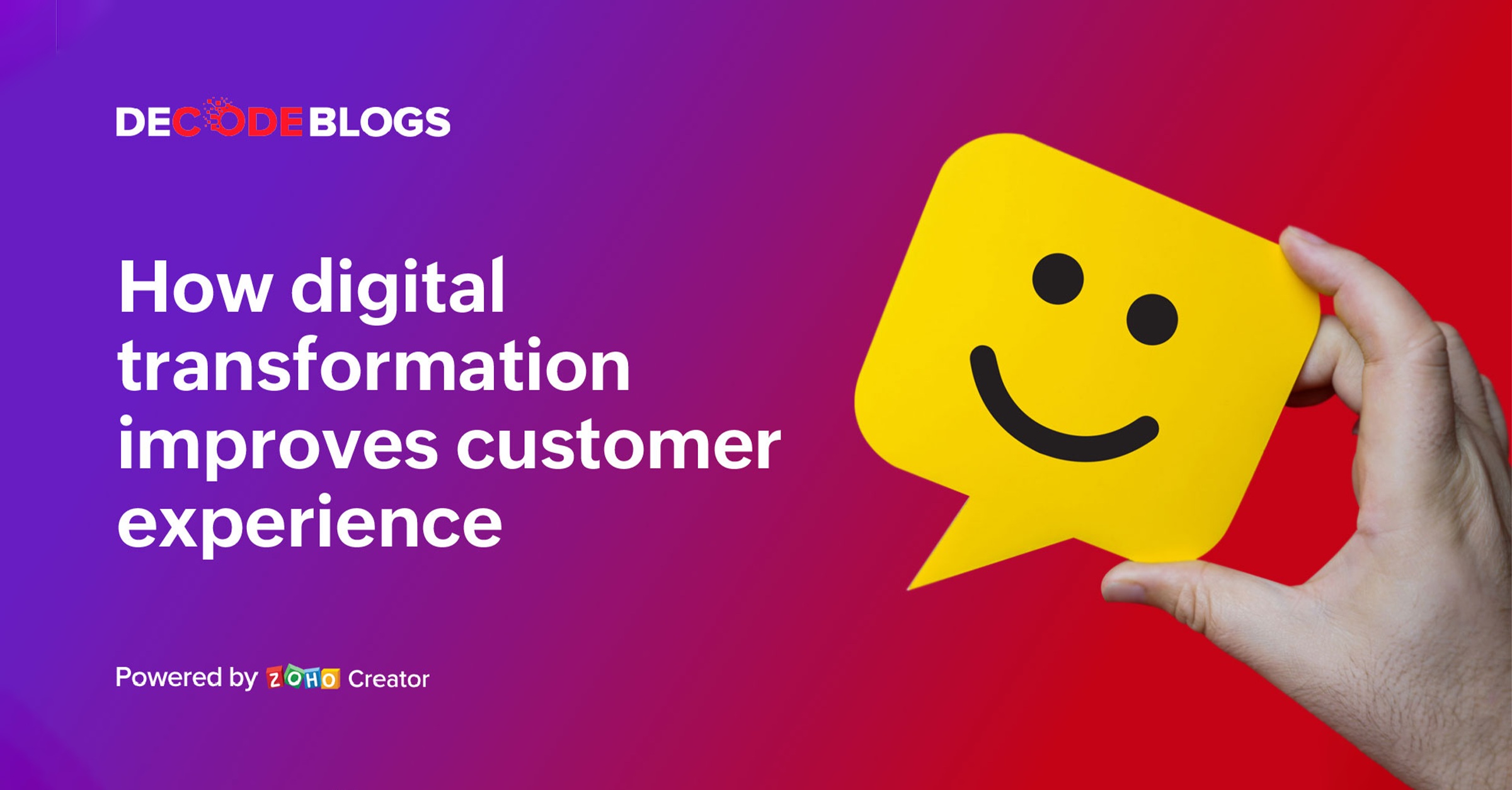- HOME
- Know Your Tech
- How digital transformation improves customer experience
How digital transformation improves customer experience
- Last Updated : April 20, 2023
- 3.5K Views
- 5 Min Read

Digital transformation in business over the last couple of decades has come in waves, but the pace of change has been increasing over time and is set to increase even further.
Technology shifts that have powered digital transformation
1. An increase in mobile phone penetration—from 1% of the population in 1995 to a whopping 73% in 2014.
2. Internet of Things (IoT)— the number of connected devices in the world is expected to reach 30 billion by the end of 2020. These connected devices and sensors, combined with faster networks and bandwidth, is enabling real-time customization.
3. Natural user interfaces, which enable people to interact with machines in a more intuitive way, have become more and more commonplace.
4. Cloud applications have become the norm. As a result, both small businesses and individual customers are getting the same level of service and technology once reserved for large enterprises.
5. Advanced analytics is making it possible to understand both internal operations and customer demand in real-time.
How customer expectations have shifted over the years
This rapid digital transformation results in a virtuous cycle of sorts. As tech-based products and services become faster, better, and more convenient, customers’ expectations increase. This increase in expectations then fuels further digital transformation which again allows customers to become even more demanding. Here are some of the major shifts in customer expectations that have taken place in the past 5-7 years:
1. Customers expect humanized, personalized experience
While the first decade of the 2000s was all about achieving scale, the next decade was about enabling a personalized experience while operating at a massive scale. Today’s customers expect a personal, unique experience at every stage—whether that’s a better understanding of their needs, a personalized customer journey, or more informed and empathetic customer care. And companies are struggling to deliver. As per Forrester, “65 percent of marketers struggle to employ emotional marketing as they turn to automation to improve customer engagement.”
2. Instant gratification is important
Customers now expect to access your platform anytime, anywhere. They also expect to reach their goals a lot quicker. Plus, with social media and instant messaging, customers have come to expect 24/7 responsiveness. What’s more, 86% of customers are willing to pay more for better customer experience—and instant responsiveness is a big part of this.
3. Consistency is the key
Since companies have different departments, often with varying needs, it’s important to find a unified, seamless customer experience. Irrespective of what’s happening within the company, no decision should be made in a way that compromises the experience for the customer. This is easier said than done: the average marketer engages through as many as 10 engagement systems. According to 65% of marketers, this makes it hard to deliver a consistent, seamless experience.
4. B2B customers’ expectations are also shifting
At the end of the day, B2B buyers are also end consumers for a whole range of products. Because of this, they are now starting to expect the same levels of personalization, ease-of-use, and on-demand access in their B2B products. They are judging the quality of products and services not just by the standards of that particular industry, but by the standards of customer experience they receive across industries. In fact, a survey found that other things remaining equal, 81% of B2B buyers would choose a supplier that offers a consumer-like experience over one that doesn’t.
How digital transformation helps in delivering a great customer experience
The good news is that technology is constantly making the leaps needed to match customer expectations. Here’s how:
1. Build greater visibility for immediate, responsive action
Good ERP systems are constantly evolving to transform the way businesses interact with customers. For instance, a good analytics setup allows detailed visibility into all an organization’s operations, enabling the team to react much quicker when firefighting. Companies now have 360-degree insight into each customer—this helps them find accurate responses faster. Plus, AI-powered chatbots are improving constantly, making instantaneous responses the norm today. Given that 80% of companies expect to compete mainly on customer experience now, this real-time responsiveness becomes key.
2. Building a humanized, personalized customer journey
Delivering a customer journey that is relevant to the unique needs of a customer is becoming much easier with big technological developments. These are the various ways in which the customer journey can be tailor-made:
- Understand how the customer found your business, what information they are seeking, and what resources they’ve viewed. Then use automation tools to create an onboarding flow that is customized accordingly.
- Use analytics to understand your existing customers’ past buying behaviour. Figure out marketing outreach, customer service channels, and product recommendations accordingly.
3. Deliver anticipatory service
Predictive service is rapidly becoming mainstream. Companies are now leveraging customer data to anticipate customer needs and provide service ahead of time. However, according to CMO Council, “Only 20% of marketers are able to predict the next best action for their customers.”
In order to get ahead of the curve and start delivering anticipatory services, companies need to take care of two main factors:
- A very effective data management system in place that allows them to leverage the data that’s coming from different sources (from social media to the company website to emails).
- Deploying advanced Machine Learning Algorithms that are designed to anticipate customer expectations.
4. Enterprise-wide collaboration for better customer experience
It’s important to understand that a seamless customer experience can’t just be the responsibility of the front-end channels. It has to come from every single department. Luckily, an advanced low-code tool can help this process of collaboration — it helps you evaluate, gather, and share all correspondence that different departments have with the client as well as their purchase history or any other insights. This will ensure that customers never have to repeat themselves during any interaction with the company — whether that’s with customer support reps, servicing staff, or sales teams.
The bottom line
While it’s true that customer expectations have shifted dramatically in the last decade, it’s the digital transformation that has powered this shift. In fact, digital transformation is continuing at a breakneck pace and has the capacity to not only meet existing expectations but even surpass them, thereby building the new set of expectations. While the technologies exist, it’s up to company leadership to figure out how to use these technologies holistically. You can either struggle to keep up with expectations or you can surpass expectations and build the future.
 Rudhra Veena
Rudhra VeenaA business analyst fascinated by the transformative power of technology on business growth. She writes about what businesses can do in a digital world— effectively leveraging software and data.



